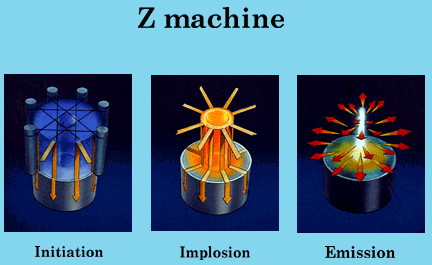
Permission to prepare a conceptual design for a next-generation accelerator, X-1, was formally requested this week by Sandia President C. Paul Robinson in a letter to DOE headquarters. If funded, X-1 would be expected to reach initial operating capability by about 2007 and high-yield fusion by about 2010 as well as provide important data for the nation’s stockpile stewardship program.
The request was made after Sandia’s continually improving Z accelerator – the most energetic and powerful laboratory producer of X-rays on Earth – achieved 1.8 million degrees Kelvin, passing the fourth and final milestone of 1.7 million degrees established by Sandia scientific researchers beginning four years ago and reviewed by scientific committees over the last two years.
In February Z had met three of its four milestones, and the fourth was near (Lab News, Feb. 27). The fourth has now been achieved.
Z would serve as a model for the larger X-1 machine. X-1 should produce X-ray temperatures of more than 3 million degrees, which, when combined with enough X-ray energy and power, should be sufficient to implode fusion capsules of deuterium and tritium (isotopes of hydrogen) to achieve high-yield fusion.
High-yield means that considerably more energy is released by a nuclear reaction than was used to ignite it. The reaction, the same type as occurs in the sun, could eventually be used to produce virtually limitless electrical power. The achievement also means that basic science experiments involving fusion capsules can begin on Z, as well as more intensive weapons physics experiments.
The basis for a series of technical breakthroughs initially involved adding more wires to a target the size of a spool of thread. Later, the size of this "wire array" was reduced, and multiple shells of wires increased the temperature even further.
Last summer the resulting progress on Z was characterized by VP Gerry Yonas (9000) as "astounding" and by a Cornell University scientist as "spectacular" (Lab News, Aug. 1, 1997). The levels of energy, power, and temperature have gone up since then.
The combination of several individual techniques for improving the uniformity of the X-ray source has resulted in the performance milestones being dramatically exceeded.
Specific milestones and achievements are:
- Energy, 1.5 megajoules; achieved, 2.0 megajoules.
- Power, 150 terawatts; achieved, 290 terawatts
- Temperature: weapons physics configurations, 100 eV (1.2 million degrees Kelvin); achieved, 140 eV (1.6 million degrees K)
- Temperature in a configuration suitable for target compression (fusion) experiments, 150 eV (1.7 million degrees K); achieved, 155 eV (1.8 million degrees K).
The team of researchers, including scientists from Sandia, Los Alamos National Laboratory, and Lawrence Livermore National Laboratory, hope that a DOE meeting to decide on proceeding with conceptual design of X-1 can be held in August.